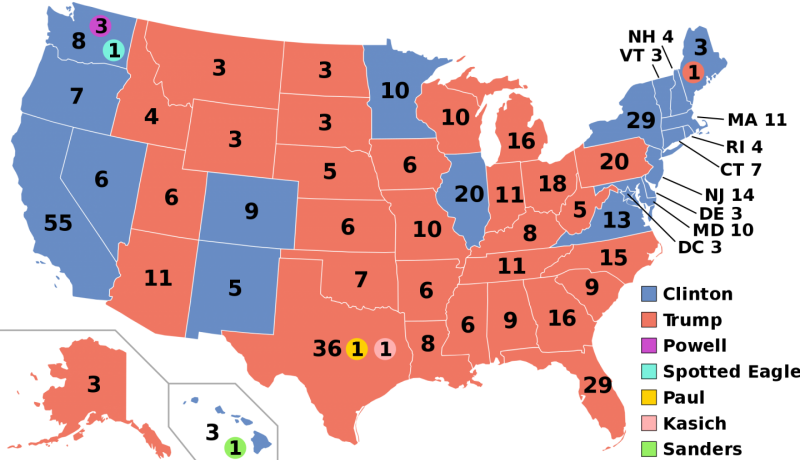Seriously, Why Do We Have the Electoral College?

On November 8, 2016, the American electorate cast 65,476,535 votes for Hilary Clinton and 62,821,935 votes for Donald Trump to be the next President of the United States, with Donald Trump declared president elect in the early hours of November 9.
In most elections, the candidate with the most votes is declared the winner and, at first glance, a Trump presidency seems a truly perverse result. Of course, Trump became president elect not because we’re horrible at counting or because the system is “rigged,” but because he had the right combination of votes where it mattered: in the Electoral College.
This marks the fifth time in U.S. history where the winner of the popular vote was not elected president, so that would mean over the course of the country’s history we have had this result about 9 percent of the time. Yet when we consider that two of these anomalies have occurred in the past five elections (Trump/Clinton 2016; Bush/Gore 2000), and if we take a closer look at Nixon’s 1968 win over Humphrey (Nixon carried the Electoral College with a convincing 301 votes to Humphrey’s 191, but the popular vote with a narrow 812,415 margin) and Nixon’s 1960 loss to Kennedy (Kennedy carried the Electoral College vote 303 to 219, but the popular vote with a razor thin 119,450 margin) we were very close to having the popular vote/electoral vote disconnect in four of the past 14 elections, which is a much more disturbing frequency (about 29 percent of the time).
So why do we use the Electoral College in the first place? Why even allow for that disconnection to occur? To answer that question, we need to go back to the 18th century.
I remind my students every semester that since our government is grounded in a document most of which was drafted more than 200 years ago, we need to appreciate the historical context if we’re ever going to make sense of our government today. After the Revolution, the United States was governed under the Articles of Confederation, and under the Articles, political power was dispersed to the states rather than concentrated in the national government (each state retained “its sovereignty, freedom, and independence”). Reflecting that power dynamic, the national government consisted solely of a single house of Congress—no national executive, no national judiciary—where each state was equal (each having one vote). The Constitution we use today was drafted to address problems (real and perceived) in the Articles, and the framers met in Philadelphia from May through September 1787, officially charged by the states to amend those Articles.
Very early in the deliberations, though, it became clear that they would be drafting a new form of government and moving to replace the Articles. Doing so was not without its risks (including exposure to charges of treason), a fact not lost on the members attending. Deliberations through the summer were conducted in secret and the members pledged not to reveal the substance of their discussions without permission of the assembly. In crafting the new government, then, they needed to be cognizant of the political climate in which they were operating – namely that they were attempting to transfer power from the states to the new national government and that they would need the cooperation and approval of the states to effect that transfer.
The structure of the government they created was shaped to address and allay concerns from the states, a fact we can see clearly in the federal model they developed and in their discussions about the new national executive. Throughout the summer, delegates discussed and debated a variety of ways to elect the president including: selection by Congress, by the people, by state governors, and, finally, by electors chosen by state legislatures. While the question of how to check the new executive dominated the discussion, the concern over how to allay objections from the states was an underlying consideration. Direct election, for instance, would strongly favor the most populous states and the most populous areas within those states and thus would be rejected by the smaller states; the idea of including state governors and state legislators in the presidential election process can also be best understood in the context of appeasing state concerns (remember, until 1913 and the adoption of the 17th Amendment, state legislatures selected senators).
The Electoral College fits within the same mold. According to Article II on the Constitution, “Each State shall appoint, in such Manner as the Legislature thereof may direct, a Number of Electors, equal to the whole Number of Senators and Representatives to which the State may be entitled in the Congress.” In leaving the selection of electors to the states, and requiring the electors to meet in their particular state to cast ballots for the president, the framers were assuring an important role for the states in the new national executive and thereby expecting a slightly smoother road for ratification.
Abolishing the Electoral College requires a constitutional amendment, and a constitutional amendment needs the approval of 38 of the 50 states (another concession to state power included in the Constitution). We have 15 states with 5 or fewer Electoral College votes. Would 3 of those states vote to weaken their power? But when we look back at the 2016 election, perhaps it may be better to ask: Does an Electoral College loss despite a two-million-vote margin in the popular vote speak more to a flawed system or a flawed campaign? Is the fault with the founders or the candidates?